Shervin Malmasi
Quantile Regression with Large Language Models for Price Prediction
Jun 07, 2025Abstract:Large Language Models (LLMs) have shown promise in structured prediction tasks, including regression, but existing approaches primarily focus on point estimates and lack systematic comparison across different methods. We investigate probabilistic regression using LLMs for unstructured inputs, addressing challenging text-to-distribution prediction tasks such as price estimation where both nuanced text understanding and uncertainty quantification are critical. We propose a novel quantile regression approach that enables LLMs to produce full predictive distributions, improving upon traditional point estimates. Through extensive experiments across three diverse price prediction datasets, we demonstrate that a Mistral-7B model fine-tuned with quantile heads significantly outperforms traditional approaches for both point and distributional estimations, as measured by three established metrics each for prediction accuracy and distributional calibration. Our systematic comparison of LLM approaches, model architectures, training approaches, and data scaling reveals that Mistral-7B consistently outperforms encoder architectures, embedding-based methods, and few-shot learning methods. Our experiments also reveal the effectiveness of LLM-assisted label correction in achieving human-level accuracy without systematic bias. Our curated datasets are made available at https://github.com/vnik18/llm-price-quantile-reg/ to support future research.
Generative Product Recommendations for Implicit Superlative Queries
Apr 26, 2025Abstract:In Recommender Systems, users often seek the best products through indirect, vague, or under-specified queries, such as "best shoes for trail running". Such queries, also referred to as implicit superlative queries, pose a significant challenge for standard retrieval and ranking systems as they lack an explicit mention of attributes and require identifying and reasoning over complex factors. We investigate how Large Language Models (LLMs) can generate implicit attributes for ranking as well as reason over them to improve product recommendations for such queries. As a first step, we propose a novel four-point schema for annotating the best product candidates for superlative queries called SUPERB, paired with LLM-based product annotations. We then empirically evaluate several existing retrieval and ranking approaches on our new dataset, providing insights and discussing their integration into real-world e-commerce production systems.
Wizard of Shopping: Target-Oriented E-commerce Dialogue Generation with Decision Tree Branching
Feb 03, 2025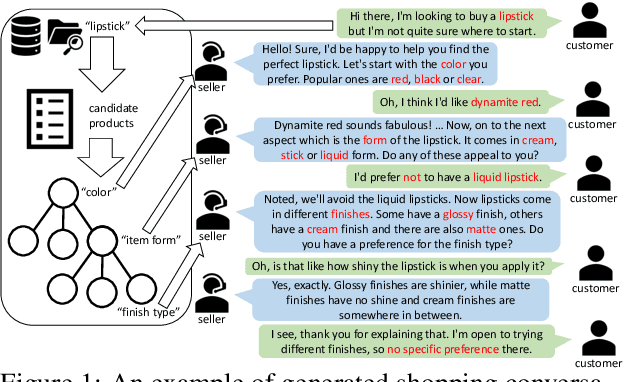

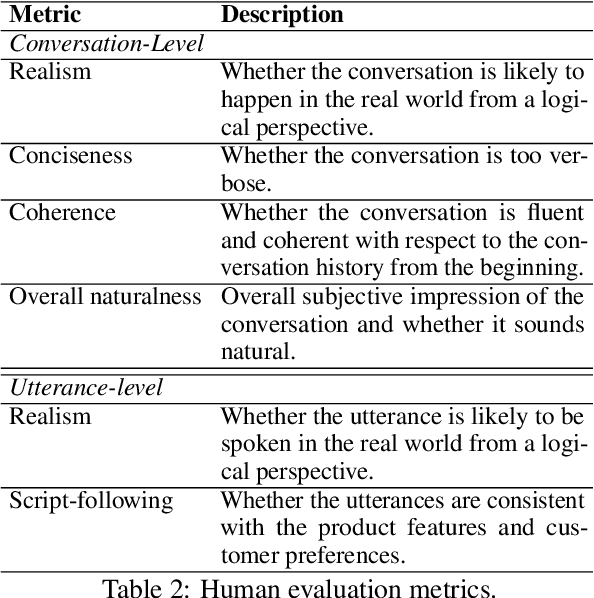

Abstract:The goal of conversational product search (CPS) is to develop an intelligent, chat-based shopping assistant that can directly interact with customers to understand shopping intents, ask clarification questions, and find relevant products. However, training such assistants is hindered mainly due to the lack of reliable and large-scale datasets. Prior human-annotated CPS datasets are extremely small in size and lack integration with real-world product search systems. We propose a novel approach, TRACER, which leverages large language models (LLMs) to generate realistic and natural conversations for different shopping domains. TRACER's novelty lies in grounding the generation to dialogue plans, which are product search trajectories predicted from a decision tree model, that guarantees relevant product discovery in the shortest number of search conditions. We also release the first target-oriented CPS dataset Wizard of Shopping (WoS), containing highly natural and coherent conversations (3.6k) from three shopping domains. Finally, we demonstrate the quality and effectiveness of WoS via human evaluations and downstream tasks.
Identifying High Consideration E-Commerce Search Queries
Oct 17, 2024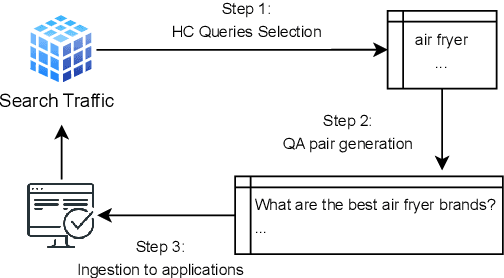
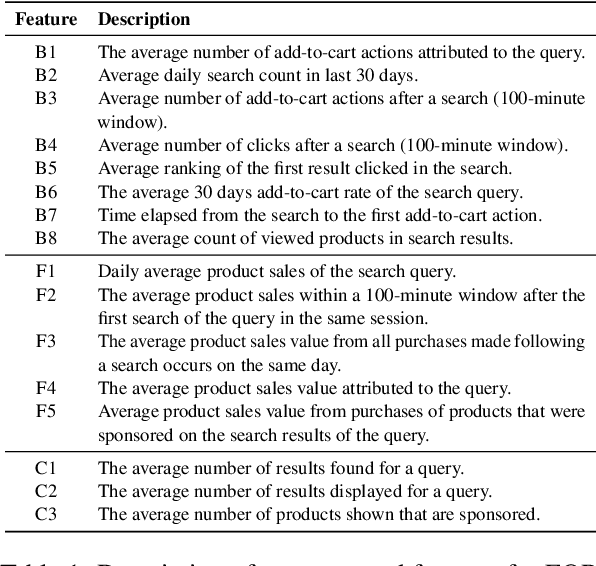
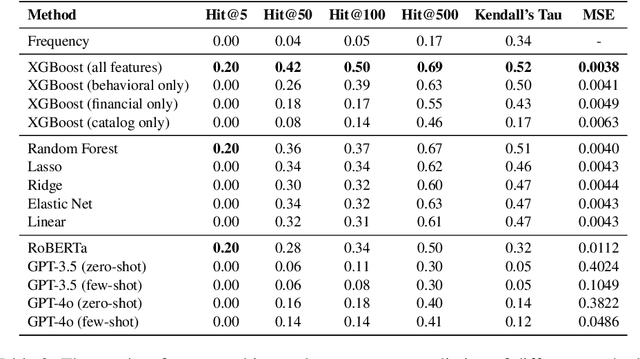

Abstract:In e-commerce, high consideration search missions typically require careful and elaborate decision making, and involve a substantial research investment from customers. We consider the task of identifying High Consideration (HC) queries. Identifying such queries enables e-commerce sites to better serve user needs using targeted experiences such as curated QA widgets that help users reach purchase decisions. We explore the task by proposing an Engagement-based Query Ranking (EQR) approach, focusing on query ranking to indicate potential engagement levels with query-related shopping knowledge content during product search. Unlike previous studies on predicting trends, EQR prioritizes query-level features related to customer behavior, finance, and catalog information rather than popularity signals. We introduce an accurate and scalable method for EQR and present experimental results demonstrating its effectiveness. Offline experiments show strong ranking performance. Human evaluation shows a precision of 96% for HC queries identified by our model. The model was commercially deployed, and shown to outperform human-selected queries in terms of downstream customer impact, as measured through engagement.
Bridging the Gap Between Information Seeking and Product Search Systems: Q&A Recommendation for E-commerce
Jul 12, 2024Abstract:Consumers on a shopping mission often leverage both product search and information seeking systems, such as web search engines and Question Answering (QA) systems, in an iterative process to improve their understanding of available products and reach a purchase decision. While product search is useful for shoppers to find the actual products meeting their requirements in the catalog, information seeking systems can be utilized to answer any questions they may have to refine those requirements. The recent success of Large Language Models (LLMs) has opened up an opportunity to bridge the gap between the two tasks to help customers achieve their goals quickly and effectively by integrating conversational QA within product search. In this paper, we propose to recommend users Question-Answer (Q&A) pairs that are relevant to their product search and can help them make a purchase decision. We discuss the different aspects of the problem including the requirements and characteristics of the Q&A pairs, their generation, and the optimization of the Q&A recommendation task. We highlight the challenges, open problems, and suggested solutions to encourage future research in this emerging area.
Generative Explore-Exploit: Training-free Optimization of Generative Recommender Systems using LLM Optimizers
Jun 07, 2024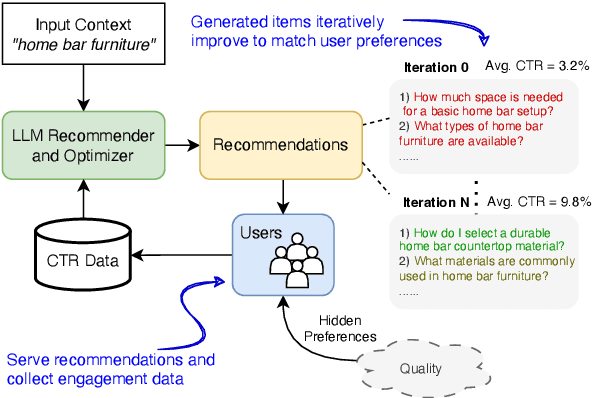



Abstract:Recommender systems are widely used to suggest engaging content, and Large Language Models (LLMs) have given rise to generative recommenders. Such systems can directly generate items, including for open-set tasks like question suggestion. While the world knowledge of LLMs enable good recommendations, improving the generated content through user feedback is challenging as continuously fine-tuning LLMs is prohibitively expensive. We present a training-free approach for optimizing generative recommenders by connecting user feedback loops to LLM-based optimizers. We propose a generative explore-exploit method that can not only exploit generated items with known high engagement, but also actively explore and discover hidden population preferences to improve recommendation quality. We evaluate our approach on question generation in two domains (e-commerce and general knowledge), and model user feedback with Click Through Rate (CTR). Experiments show our LLM-based explore-exploit approach can iteratively improve recommendations, and consistently increase CTR. Ablation analysis shows that generative exploration is key to learning user preferences, avoiding the pitfalls of greedy exploit-only approaches. A human evaluation strongly supports our quantitative findings.
Question Suggestion for Conversational Shopping Assistants Using Product Metadata
May 02, 2024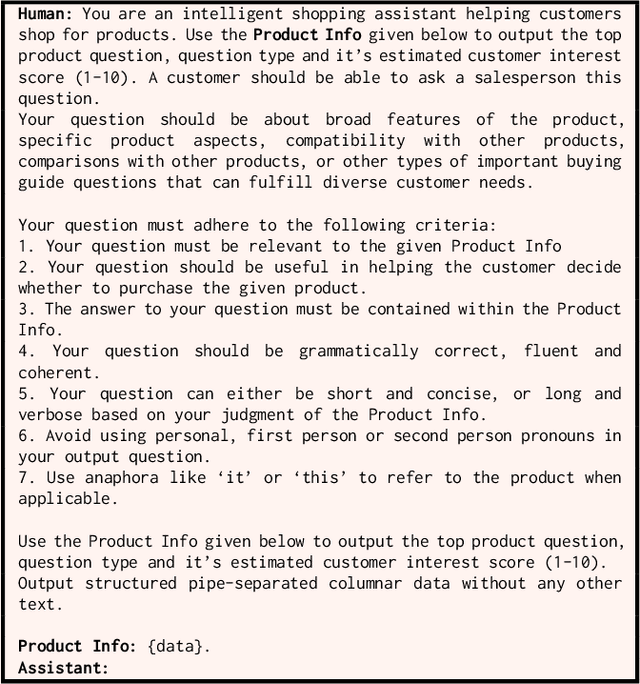
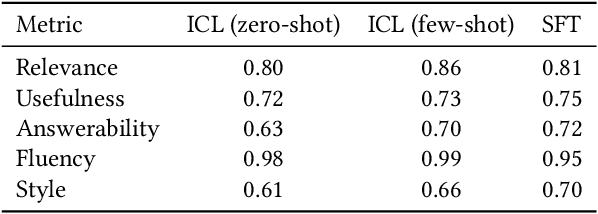
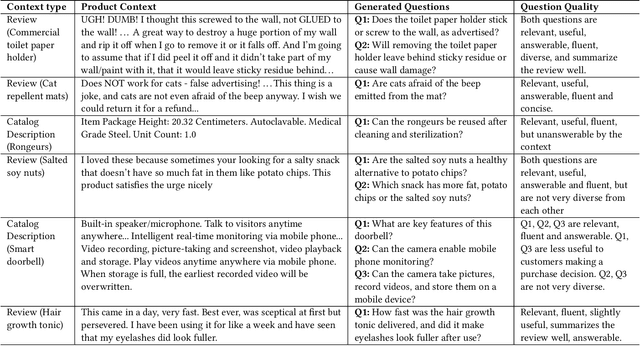
Abstract:Digital assistants have become ubiquitous in e-commerce applications, following the recent advancements in Information Retrieval (IR), Natural Language Processing (NLP) and Generative Artificial Intelligence (AI). However, customers are often unsure or unaware of how to effectively converse with these assistants to meet their shopping needs. In this work, we emphasize the importance of providing customers a fast, easy to use, and natural way to interact with conversational shopping assistants. We propose a framework that employs Large Language Models (LLMs) to automatically generate contextual, useful, answerable, fluent and diverse questions about products, via in-context learning and supervised fine-tuning. Recommending these questions to customers as helpful suggestions or hints to both start and continue a conversation can result in a smoother and faster shopping experience with reduced conversation overhead and friction. We perform extensive offline evaluations, and discuss in detail about potential customer impact, and the type, length and latency of our generated product questions if incorporated into a real-world shopping assistant.
Identifying Shopping Intent in Product QA for Proactive Recommendations
Apr 09, 2024


Abstract:Voice assistants have become ubiquitous in smart devices allowing users to instantly access information via voice questions. While extensive research has been conducted in question answering for voice search, little attention has been paid on how to enable proactive recommendations from a voice assistant to its users. This is a highly challenging problem that often leads to user friction, mainly due to recommendations provided to the users at the wrong time. We focus on the domain of e-commerce, namely in identifying Shopping Product Questions (SPQs), where the user asking a product-related question may have an underlying shopping need. Identifying a user's shopping need allows voice assistants to enhance shopping experience by determining when to provide recommendations, such as product or deal recommendations, or proactive shopping actions recommendation. Identifying SPQs is a challenging problem and cannot be done from question text alone, and thus requires to infer latent user behavior patterns inferred from user's past shopping history. We propose features that capture the user's latent shopping behavior from their purchase history, and combine them using a novel Mixture-of-Experts (MoE) model. Our evaluation shows that the proposed approach is able to identify SPQs with a high score of F1=0.91. Furthermore, based on an online evaluation with real voice assistant users, we identify SPQs in real-time and recommend shopping actions to users to add the queried product into their shopping list. We demonstrate that we are able to accurately identify SPQs, as indicated by the significantly higher rate of added products to users' shopping lists when being prompted after SPQs vs random PQs.
Leveraging Interesting Facts to Enhance User Engagement with Conversational Interfaces
Apr 09, 2024



Abstract:Conversational Task Assistants (CTAs) guide users in performing a multitude of activities, such as making recipes. However, ensuring that interactions remain engaging, interesting, and enjoyable for CTA users is not trivial, especially for time-consuming or challenging tasks. Grounded in psychological theories of human interest, we propose to engage users with contextual and interesting statements or facts during interactions with a multi-modal CTA, to reduce fatigue and task abandonment before a task is complete. To operationalize this idea, we train a high-performing classifier (82% F1-score) to automatically identify relevant and interesting facts for users. We use it to create an annotated dataset of task-specific interesting facts for the domain of cooking. Finally, we design and validate a dialogue policy to incorporate the identified relevant and interesting facts into a conversation, to improve user engagement and task completion. Live testing on a leading multi-modal voice assistant shows that 66% of the presented facts were received positively, leading to a 40% gain in the user satisfaction rating, and a 37% increase in conversation length. These findings emphasize that strategically incorporating interesting facts into the CTA experience can promote real-world user participation for guided task interactions.
Enhancing Low-Resource LLMs Classification with PEFT and Synthetic Data
Apr 03, 2024Abstract:Large Language Models (LLMs) operating in 0-shot or few-shot settings achieve competitive results in Text Classification tasks. In-Context Learning (ICL) typically achieves better accuracy than the 0-shot setting, but it pays in terms of efficiency, due to the longer input prompt. In this paper, we propose a strategy to make LLMs as efficient as 0-shot text classifiers, while getting comparable or better accuracy than ICL. Our solution targets the low resource setting, i.e., when only 4 examples per class are available. Using a single LLM and few-shot real data we perform a sequence of generation, filtering and Parameter-Efficient Fine-Tuning steps to create a robust and efficient classifier. Experimental results show that our approach leads to competitive results on multiple text classification datasets.
 Add to Chrome
Add to Chrome Add to Firefox
Add to Firefox Add to Edge
Add to Edge